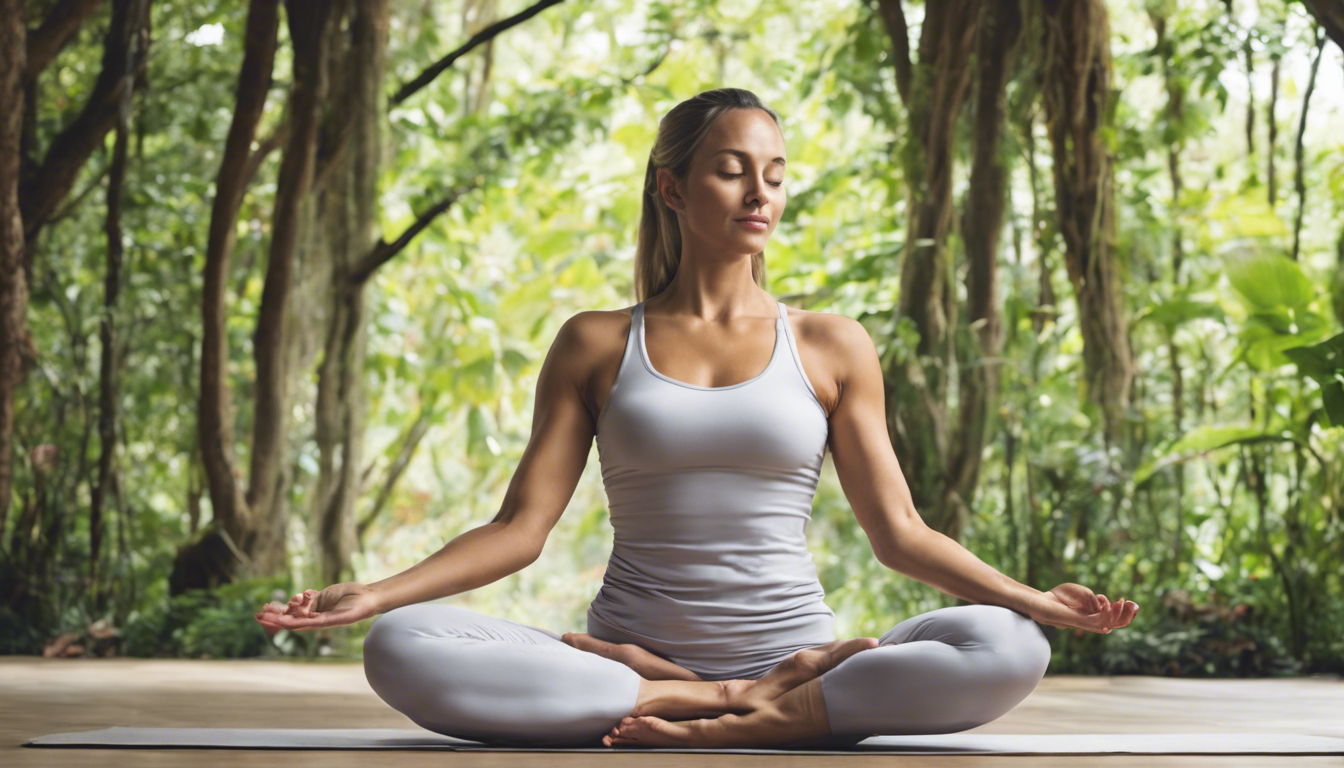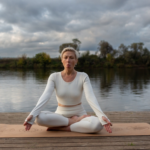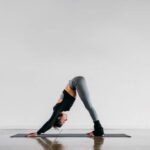Sneak Peak
“Hatha Yoga and Meditation” Mastering yoga meditation is a holistic path. It leads to a harmonious mind-body balance. Combining yoga and meditation enriches both. It adds to the physical benefits of yoga. It also adds to the mental clarity from meditation. This blend is often called the yoga of meditation. It isn’t for relaxation. It is also a deep way to build mindfulness, improve emotions, and foster inner peace. The significance of yoga meditation is huge. It helps with physical agility and mental serenity. It gives a full approach to health and wellness.
This article will explore seven ways to add meditation to yoga. It will focus on adding meditation to Hatha Yoga. It starts with basic asanas that prepare the body for meditation. It adds pranayama for breath control. Then, it uses meditation to cool down after a session. Each step is crucial for enhancing the yoga as meditation experience. Additionally, we’ve discussed blending yoga with daily meditation. This will focus on breath awareness and use guided visualization. We will also cover alternating between different practices. Finally, we will stress ending each session with thanks. Then, we will reflect. This provides a road map for mastering how the two disciplines work together.
Start with Basic Asanas. Hatha Yoga and Meditation

Warm-Up Poses
Starting a yoga session with simple asanas is crucial. They prepare the body for harder practices. Start with gentle stretches, like pelvic tilts and planks. These can boost core strength. Core strength is vital for keeping good posture during yoga. These exercises build abs. Abs support the lower back and warm up the legs. The legs are crucial for every yoga pose.
Many people love the cat-cow stretch. It opens the chest, back, and neck. This promotes deeper, slower breathing. This is key for proper yoga, 13. Also, it also includes poses like the downward-facing dog and the goddess pose. During the warm-up, athletes perform them to stretch and strengthen muscles. They prepare the body for complex movements.
Stretching Techniques
Yoga’s stretching techniques improve flexibility. They also boost blood flow and cut injury risk. The easy twist pose is great for increasing spine and shoulder flexibility. It warms up key muscles needed for more complex poses. The eagle pose improves balance. It also opens the hips, which helps with deeper breathing.
It’s great for those working on leg flexibility. The eye of the needle pose is a useful stretch. It increases mobility in areas that may tighten during workouts. Each session should start with basic standing postures. In these, individuals press all four corners of their feet to the floor. They lengthen their arms and draw their shoulders backward. They engage the thighs and belly for a strong foundation.
By adding these warm-up poses and stretches, yogis can ensure a complete yoga session. It’ll stress the muscles less and maximize the benefits of Hatha Yoga.
Incorporate Pranayama

Breath Control Exercises
Pranayama is a key part of Hatha Yoga. It involves regulating breath through various techniques. This enhances both physical and mental wellness. These exercises include controlled inhalation, exhalation, and breath retention. They should make breathing subtle and long. Classical texts like the Hathapradipika emphasize pranayama. It stabilizes the mind by controlling breath patterns. They include Nadi Shodhana (alternate-nostril breathing). Also Ujjayi (victorious breath), and Brahmari (humming bee breath). These techniques are key to cleansing the body for higher spiritual awareness.
Pranayama is not about breath control. It is also about channeling pranic energy through the body’s subtle channels. This enhancement of health and vitality occurs. This control of breath helps energy flow. It affects the practitioner’s mind and emotions. This leads to a balanced autonomic nervous system. This system has more parasympathetic activities. Doing pranayama, like the Breath of Fire, often. It can increase lung capacity. It can also boost oxygen flow. It helps with emotional release and nervous system adjustments too.
Energy Flow Enhancement
Pranayama techniques enhance energy flow in the body. The double breath technique is one such practice. It involves a rhythmic inhale and exhale paired with body movements. It energizes and revitalizes the practitioner. This practice encourages the flow of stagnant energy. It promotes dynamic flow throughout the body. Also, doing standing and seated pranayama exercises helps. They build an awareness of the body’s energy levels. They allow practitioners to feel and direct this energy.
Pranayama practice helps physical health. It aids digestion and boosts metabolism. It also helps mental health. It does this by improving focus, memory, and other mental skills. It’s known for its therapeutic benefits. It helps manage conditions like depression, insomnia, and respiratory disorders. Also, the practice is crucial for preparing the body and mind for deeper meditation. It is an essential part of advanced yoga in 1925.
Do these pranayama techniques every day. They can increase your life force, or prana. This leads to better health and a deeper connection with oneself.
Use Meditation to Cool Down

Post-Yoga Meditation
After doing yoga, it’s good to transition to mental relaxation with meditation. Find a comfortable seated position. Use a firm block or cushion. They help keep the spine’s natural curve. It’s important to let the eyes close. Then, focus attention inward to tune into the breath. This practice helps extend the calm and centered feeling from yoga.
Incorporating visualization techniques can enhance this cooling-down process. One might picture a peaceful woodland. They might imagine walking through it and using all senses to deepen the relaxation. This visualization helps in mental relaxation. It also helps in gaining insights and reflections. These can nurture the mind and soul.
Mindfulness Practices
During the cool-down phase of yoga, you must maintain mindfulness. This means being aware of the present moment. Practitioners focus on the breath and observe body sensations without judgment. This cultivates a deep sense of presence. This approach isn’t about emptying the mind. It’s about observing and accepting thoughts and sensations as they come and go. This enhances the meditative experience.
Engaging in mindfulness can involve imagining a white light coming from the heart. It can involve creating a protective aura around oneself. This light represents the positive energy from yoga. It helps keep the benefits of the session as one transitions back to daily life. Encourage practitioners to reflect on the effects of the practice. They should notice any feelings of freedom or clarity that have emerged.
Adding these mindfulness practices at the end of a yoga session boosts its benefits for the body and mind. They also improve their ability to carry these benefits into their daily lives. This promotes sustained well-being and mindfulness.
You May Also Like:
Hatha Yoga Boosts Your Mental Health and Happiness: 7 Proven Ways
Blend Yoga with Daily Meditation

Adding yoga and meditation to daily routines has big benefits. They help both physical and mental health. By blending these practices, people can achieve a more complete approach to wellness. It boosts the physical benefits of yoga. It also improves the mental clarity from meditation.
Routine Integration
To add yoga and meditation into daily life, start by setting aside times for practice. This regularity helps make a routine. The routine supports sustained engagement and deeper benefits. It’s best to start with short meditations. Then, increase the time as you get more comfortable with the practice.
Meditating after yoga poses can shift you from activity to stillness. This progression goes from movement to meditation. It helps the body to relax and the mind to clear. It’s making the practice both sustainable and more effective.
Benefits of Daily Practice
Regular yoga and meditation can improve one’s well-being. Yoga prepares the body for meditation. It does this by making long periods of sitting more comfortable. Meditation deepens mental clarity and peace. It fosters a deep connection with oneself.
The dual practice also contributes to improved stress management. Yoga eases physical tension. Meditation addresses the mind and emotions. This leads to less anxiety and better emotional strength. Also, this daily practice can improve sleep. The mind becomes good at entering a relaxed state. It’s benefits from the restorative effects of both yoga and meditation.
People improve their physical and mental health by adopting these practices. They do so in daily life. They also gain a deeper sense of purpose and mindfulness. This enriches their life experience.
Focus on Breath Awareness

Focusing on breath awareness is key to deepening yoga. It also enhances its benefits for mental and physical health. By syncing breath with movement, people can gain more emotional balance. They can also improve concentration.
Synchronizing Breath and Movement
Coordinating movements with breathing is crucial in yoga. Encourage them to focus on their breathing. It should be deliberate and aligned with their movements. This synchronization helps in calming the nervous system and improving emotional health. It also boosts focus. Focus is key for successful yoga practice. Also, syncing breath with movement during transitions is key. This happens in asanas, like in sun salutations. It keeps a steady flow. It stops jerky movements, making the practice more meditative and fluid.
Mindfulness in Motion
Adding mindfulness to yoga involves deep awareness of the present. It means focusing on how the body feels and how each breath affects the body. This awareness helps practitioners recognize their habits of reactivity. It lets them choose how to respond to sensations and emotions. For instance, during asana practice, mindfulness lets people observe discomfort. It helps them tell what is uncomfortable from what might be harmful. It encourages a more nurturing approach to the body.
Practicing mindfulness in motion involves acknowledging impermanence. This includes physical sensations and emotions. By watching these changes without attachment, practitioners can accept life’s fleeting nature better. This reduces suffering and improves mental clarity.
Also, focusing on breath awareness during yoga supports physical alignment and stability. It also helps you connect with yourself more. It lets practitioners step back from the flow of thoughts and emotions. It gives them a space of clarity and calmness.
Integrate these practices into your daily yoga. They can help you handle stress. They can help you breathe better. They can help you toughen up and adapt.
Practice Guided Visualization

Imagery Techniques
Guided visualization is a powerful practice in yoga meditation. It involves the use of imagery to improve mental and physical well-being. Practitioners often picture themselves surrounded by a natural energy field. It can take the form of elements like water, fire, wind, or light. This energy flows through the body. It enters at the crown and moves downward. It revitalizes or heals as it travels. This practice helps relaxation. It also directs energy to body parts that need healing. Practitioners visualize energy flowing out through the feet. This helps them expel toxins and negativity, boosting the healing process.
During yoga, you can deepen the experience by adding pranic healing visualizations. You can add them during practices like pranayama. When inhaling, you can visualize drawing in lots of healing prana with each breath. Holding the breath allows the imagined prana to fill the body. It brings intense rejuvenation. During exhalation, you visualize expelling toxins with the breath. This completes the cycle of renewal. This method increases the breathing exercises’ effect. It also strengthens mental focus and body connection.
Mental Focus Exercises
Guided visualization helps improve mental focus. Specific exercises do this. One effective technique is to do an asana. Then, it’s essential to visualize doing it before trying the pose again. This exercise uses the mind to influence the body. It shows how a focused mind can control the body.
Another way to enhance focus is to use detailed imagery in yoga poses. For example, in Mountain Pose, one might think of their feet as growing roots into the ground. This enhances stability and focus. Imagining the spine lengthening can help. So can imagining the breath flowing like a bright light through the body. These practices can improve posture and breathing efficiency.
These visualization techniques make yoga more engaging. They also help cultivate a deeper self-awareness and connection. By picturing detailed images, practitioners can block out distractions. This leads to a deeper meditation.
Alternate Between Practices

Balancing Yoga and Meditation
Switching between different practices is key. These include yoga and meditation. It’s essential for a balanced routine. It’s recommended to start the day with meditation. This sets a base of calm and focus. Later, yoga can support this. A doable schedule might include morning meditation. Then, gentle yoga or a walk. And more meditation sessions. This approach ensures that meditation remains the core practice. It improves the benefits of yoga by keeping a relaxed and clear mind throughout the day.
For those blending yoga with other activities, do yoga on some days. Do things like weightlifting on others. This can be helpful. This allows the body to rest and gain flexibility. This is crucial for more strenuous activities. A balanced schedule might involve yoga sessions. They focus on stretching and flexibility. They happen on alternate days from weightlifting. The yoga helps to keep muscles elastic and prevent stiffness. Hatha Yoga and Meditation
Sample Schedules
A sample schedule for balancing yoga and meditation could look like this. Start with morning meditation. Then, do a light yoga session. Mid-morning might include a focused study or practice session. For example, learning to teach yoga or deep philosophical studies. The afternoon could be for anatomy studies. Then, there would be another yoga class. The day could end with a meditation to think over the day’s practices and thoughts.
Another example could be early morning sitting meditation. After that, there is a gentle yoga session. Most of the morning could then be for more meditation. This could be sitting or walking to deepen the practice. The late afternoon could include another session of yoga or meditation. It’s would bring balance to the day’s activities.
These schedules build flexibility and strength. They also boost mental clarity and emotional stability. They create a holistic approach to wellness. It uses the strengths of both yoga and meditation. By sticking to a clear but flexible routine, practitioners can get the most out of each practice. This ensures that they complement, not conflict with each other.
Finish with Gratitude and Reflection

End Session Techniques
Yoga sessions end with final relaxation, often called Shavasana or easy posture (Sukasana). This step is vital. It helps integrate the benefits of the physical practice into the body and mind. This posture invites practitioners to lie down. They allow their feet to relax to the sides and their hip joints to soften. They release into the ground. This gentle turn outward relaxes the legs. It makes them feel heavy and soft as they release into the earth.
The back of the pelvis should also soften. This will add to a full-body release. Additionally, letting the shoulders open. This helps the upper back relax for deeper relaxation. Encourage practitioners to embrace a simple state of relaxation. They may even allow a soft smile to take over their face. This state embodies total release and relaxation.
Adding relaxation techniques at the end of the session. This can deepen the healing effects. Examples include stage-by-stage relaxation and body scanning. These methods help you relax each body part one at a time. They make the whole relaxation process much better. It’s helpful by guiding practitioners through mental exercises. The exercises focus on one thought or object at a time. They can also be a powerful way to conclude a yoga session.
Reflective Practices
Reflective yoga practices encompass many techniques. They bring practitioners back to self-awareness and mindfulness. These practices can include sitting or walking meditations. The focus is on observing the present moment and the sensations in the body without judgment. Journaling after a yoga session is another reflective practice. It lets you express thoughts and emotions from the practice. This can be a free-flowing exercise. Practitioners write without pausing to edit or organize thoughts. This helps them connect with their inner self more deeply.
Music and art can also serve as reflective practices. Paying full attention to a piece of music or art lets people connect with their emotions. It also lets them connect with the sensations these experiences cause. This focus helps to cultivate mindfulness and presence. They’re vital for personal growth and understanding.
Furthermore, incorporating gratitude can enhance reflective practices. Reflect on what you’re thankful for. You can do this through gratitude meditation or by acknowledging life’s gifts. It can transform the yoga practice into a more enriching experience. This practice cultivates a positive mindset. It also boosts emotional resilience. This resilience helps people face life’s challenges with grace and gratitude.
Adding end sessions and reflective practices to their routine helps. They let individuals end yoga on a nurturing note. They also extend yoga’s benefits to other parts of their life. This promotes well-being and mindfulness.
Conclusion
We explored adding yoga meditation to Hatha Yoga. We looked at steps to deepen the benefits of yoga. These steps improve both body and mind, boosting well-being. It starts with basic asanas. Then, it adds pranayama for breath control. It ends with gratitude and reflection. Each part is a key in creating a full yoga experience. This approach promotes physical health and flexibility. It also fosters mental clarity, emotional strength, and deep inner peace. The session highlighted the importance of adding daily meditation to yoga. It stressed its power to transform the mind and body.
The journey includes various practices. These practices focus on breath and guided visualization. They show the depth and breadth of yoga meditation. Practitioners alternate between practices. They integrate these techniques into daily routines. This equips them with a versatile toolkit. It helps them navigate life’s challenges with more ease and mindfulness. These approaches show the importance of a balanced practice. It should cultivate not physical agility but also mental serenity. This contributes to a healthy lifestyle. Embracing these practices brings a deeper connection with oneself. It also brings a richer, nuanced understanding of the art of yoga meditation.









